
Editor's Note
Positives in defeat
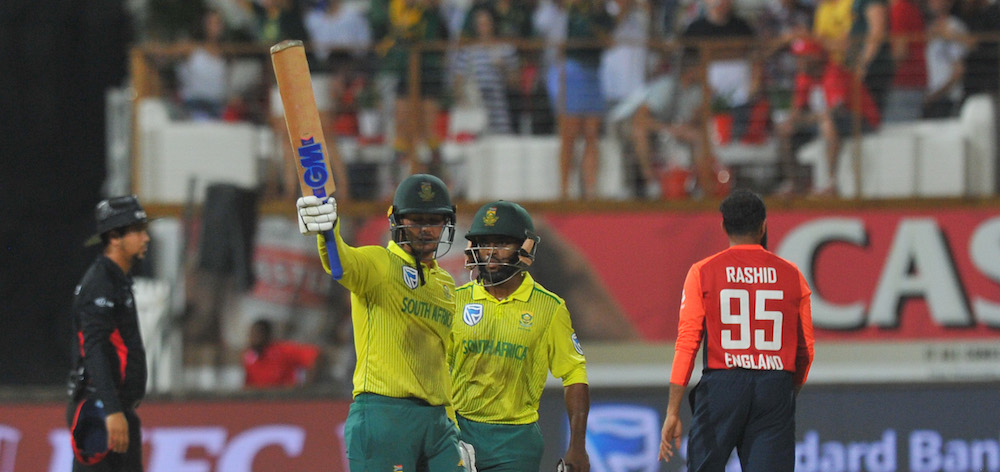
The Proteas series concluded with yet another humdinger of a clash. England walked away as overall winners having beaten South Africa in the Test series 3-1, drawing the ODI series 1-1 and clinching the T20I series 2-1.
Although there has been continuous talks about the Proteas being in a "rebuilding phase", which was fully shown in the manner in which they lost the Test series, there were some positives to draw out of England's visit.
The major positives came during the Proteas' white-ball efforts. They showed great fight and character throughout the ODI and T20I series, and although they never won the series', they can definitely hold their head up high.
Quinton de Kock as captain was refreshing and he led from the front superbly in the white-ball arena. There is definitely a lot he can learn with regards to talking to the media, but with regards to his cricketing brain and effectiveness on the field, there are no major criticisms from me.
In this issue we relive the T20I series and provide you with some of the top moments.
Faf du Plessis started this new week by stepping down as captain across all formats and we bring you his statement.
We also bring to you some of the best features and interviews that we have done in the last week.
For the love of the game,
KHALID MOHIDIN
Editor
Cricket Fanatics Magazine
Playing “Smart Cricket” is the aim – Mark Boucher
Mark Boucher speaks to the media after the Proteas’ 5-wicket defeat to England in Centurion that ultimately lost them the T20I series 2-1.
FAF DU PLESSIS STEPS DOWN AS CAPTAIN
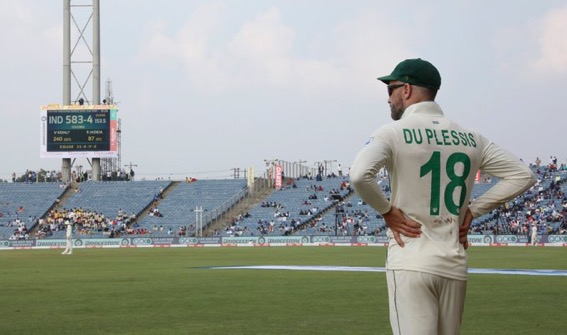
Faf du Plessis has stepped down as captain of the Proteas’ Test and T20 teams effective immediately.
The 35-year-old has cited a need to take a step back from captaincy in order to help facilitate the emergence of the next generation of leaders within the team under the new stewardship of Quinton de Kock.
With a calendar that is jam packed with international tours both home and away, including the ICC Men’s T20 World Cup in Australia this October and November, Du Plessis would like to concentrate on contributing to the team as a batsman and senior player who will offer guidance and advice to the new leadership group as part of their succession planning.
Du Plessis has captained South Africa in a total of 112 international matches across all three formats since December 2012 when he led South Africa for the very first time against New Zealand in a T20 series.
The hosts won that three-match contest 2-1. Since then, he has scored 5 101 runs in all formats as captain amassing 11 centuries and 28 half-centuries as he went.
He led the Proteas in several famous victories, including the team’s five-nil inbound ODI series and 2-1 outbound Test series victories against Australia in 2016.
His statement is as follows;
“The last few weeks of rest away from the game have given me a lot of perspective on the great privilege and honour I have had in representing and leading my country in the three formats of this wonderful game.
"It has been a rewarding, sometimes tough and other times a lonely road, but I would not replace the experience for anything, because it has made me the man that I am proud to be today.
“When I took over the leadership, I did so with the commitment to lead, perform and most importantly, to serve. As the team heads into a new direction with new leaders and a young crop of players, I feel it will be in the best interests of South African cricket to relinquish the captaincy in all formats.
"This was one of the toughest decisions to make, but I remain fully committed to supporting Quinton, Mark and my teammates as we continue to rebuild and re-align as a group.
“After the 2019 ICC World Cup, I made the decision to continue in my role as captain while the team went through a rebuilding phase following the retirement of some key senior players and a complete overhaul of the coaching staff that we had worked with until then.
"It was important to me that I stayed to help the team find its feet and plot a new way forward while assisting in identifying the next generation of leaders within the players’ group during a time of turbulence in SA cricket.
"The last season of my captaincy has been the most challenging to date as I had a lot of off-field issues that I devoted my energy towards.
“I have strived to lead the team with dignity and authenticity during exhilarating highs and devastating lows. I have given my everything during my tenure. I have never been one to throw in the towel and do believe I am putting the team first and believe we have to stick through the tough times to get to the good times.
"In a perfect world I would have loved to lead the team in the Tests for the rest of the season as well as the T20 World Cup, but sometimes the most important attribute of a leader is to be selfless. I am healthy, fit, energised and motivated and certainly see myself playing an important role in the squad for as long as I continue putting in winning performances for the team.
“South African cricket has entered a new era. New leadership, new faces, new challenges and new strategies. I remain committed to play in all three formats of the game for now as a player and will offer my knowledge and time to the new leaders of the team.
“Finally, I would like to take this opportunity to express my deepest gratitude to everyone who has supported me in my captaincy throughout the years – my wife and daughter, family, teammates, Proteas coaching staff, management and selectors, CSA Board and staff, friends and fans of South African cricket. It has been the greatest honour of my life to lead my country.”
CSA Acting CEO, Dr Jacques Faul expressed his thanks to Du Plessis for his contribution to South African cricket and his stellar leadership of the Proteas.
“Faf’s record as player and captain speaks for itself,” commented Dr. Faul. “He has maintained the high standards he set for himself when he made a match-saving Test match century in Australia on debut in spite of the added responsibilities and pressures that come with leadership.
“He is the only South African captain to have won home and away series against Australia – one of the benchmark nations of the game – in both Test match and ODI cricket and he also won a one-off T20 International series in Australia.
“He has always reserved his best performances for when the team’s need was the greatest as witnessed by his debut century in Australia, his century against India at the Imperial Wanderers that almost enabled the Proteas to pull off a record fourth innings runs chase and his century as captain in the pink ball Test at Adelaide when he was under enormous pressure both on and off the field.
“His latest decision reminds us all of the manner in which he has always put the team first. Following the retirement of Vernon Philander he and Dale Steyn are the last survivors of the golden generation that took the Proteas to the top of the Test rankings and he still has a vital role to play as we bridge the gap between one generation and the next.
“I am sure he will continue to add much value to the Proteas both on the field and in the dressing room in the final chapter of his outstanding career,” concluded Dr. Faul.
PLAYER MOMENTS: SENSATIONAL EOIN MORGAN SEALS SERIES FOR ENGLAND
By Khalid Mohidin
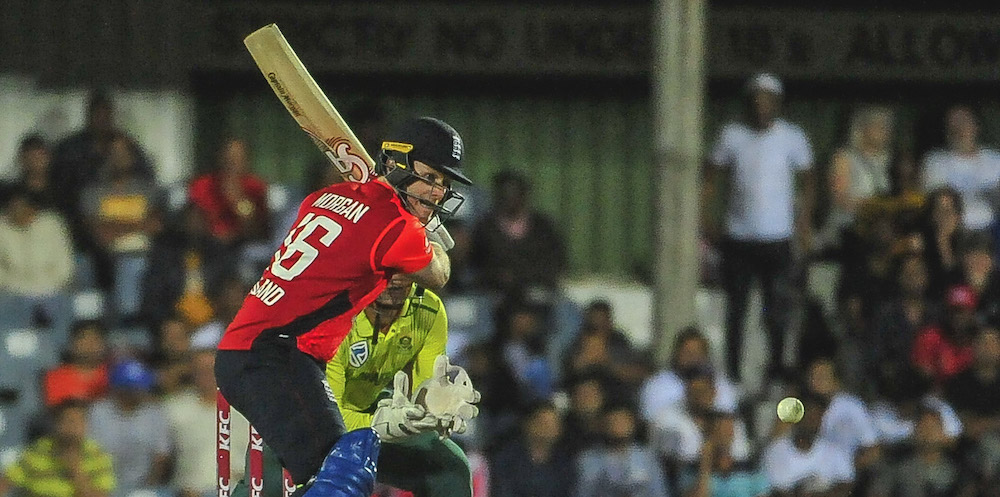
Eoin Morgan crushed South African hearts as he helped England chase down a target of 223 to win the series 2-1, writes Khalid Mohidin.
ALSO READ: PLAYER MOMENTS: HEINRICH KLAASEN’S MARVELLOUS HALF-CENTURY
Bairstow was seeing the ball beautifully as he hit 3 sixes and 7 fours for his 34-ball 64, as England marched to 140 in 12.3 overs.
Phehlukwayo came in and as he has done on so many occasions, he took a game-changing wicket, knocking over the top Bairstow’s stumps with a slower delivery.
Tabraiz Shamsi, after going for 38 in 2 overs, fought back by finding Dawid Malan’s bottom edge, De Kock taking a difficult low catch.
This took the required rate to over 12 an over.
England’s great start was also majorly influenced by a great knock from Jos Buttler, who hit a 29-ball 52 (9 fours, 2 sixes), but it was Eoin Morgan and Ben Stokes now had the task of completing an epic chase.
They put on 61 runs before Lungi Ngidi took the crucial wicket of Ben Stokes to keep South Africa in the fight.
Moeen Ali was then dropped by Dwaine Pretorius in the middle of the 19th over.
Morgan was sensational. He dealt just in sixes, 7 of them for his 22-ball 57.
Ruthless aggression by England as they won by five wickets after chasing down 223 with an over to spare.
England won the series 2-1.
Photo: Deryck Foster/BackpagePix
A MATCH MADE IN HEAVEN
By Khalid Mohidin
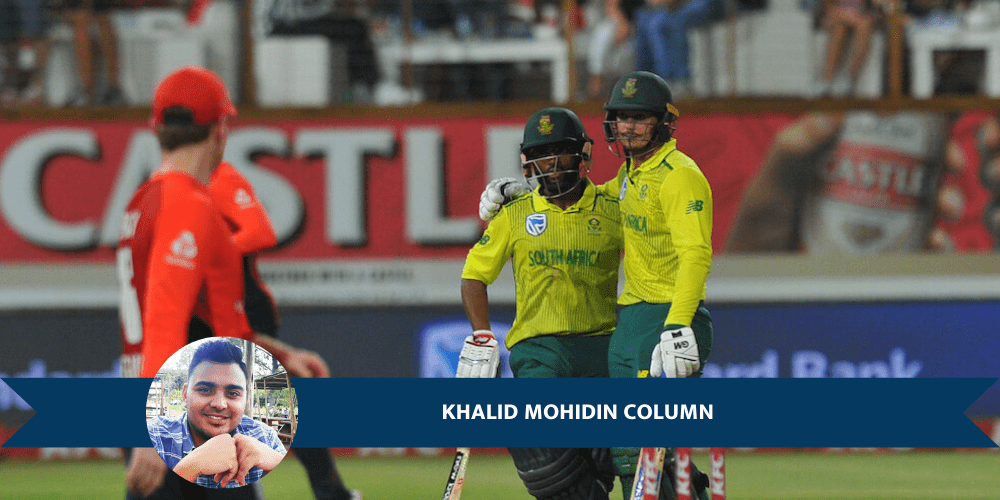
Temba Bavuma and Quinton de Kock won the hearts of many during the T20I series between the Proteas and England, and should be the Proteas’ opening duo during the T20I World Cup, writes Khalid Mohidin.
It was refreshing to see a Proteas opening pair dominate once again. The pair of Bavuma and De Kock scored 48, 92 and 84 in their three opening stands. A total of 224 runs in three games.
Compared to England’s pair who scored 19, 17 and 15.
They say dynamite comes in small packages, and boy does Bavuma keep proving that statement. Opening the batting with De Kock, he showed his intentions by playing a variety of roles – the anchor, aggressor and the stabilizer.
What was particularly pleasing was the way he complimented De Kock. His natural ability to switch according to the circumstances was what stood out to me, particularly when De Kock looked a little wobbly after facing a couple of dot balls.
De Kock, when feeling a little jittery, felt confident to take a single, give the strike to Bavuma who would hit a well-timed boundary to lift the pressure off De Kock on the other end. This also proved their understanding and trust in each other.
Having a stable partner who can absorb the pressure is key, and Bavuma’s natural style of play is exactly what De Kock needs, to allow him to play his natural game.
In five T20I games between them as a partnership, they managed to pass 50 four times and have scored a total of 345 at an average of 86.
With his previous partner, Hashim Amla, he played 19 games and averaged 30.
In 8 matches with Reeza Hendricks, he managed 262 runs at an averaged 32.75, they only managed to pass 50 on two occasions.
This seems like an easy decision for the Proteas’ brains trust putting into perspective how well Bavuma and De Kock have teamed up during the series against England. All signs and support from the fans show that it is an easy choice to make.
But let’s see how the pair fair in the T20I series against Australia and make our final decision.
Disclaimer: Cricket Fanatics Magazine encourages freedom of speech and the expression of diverse views from fans. The views of this article published on cricketfanaticsmag.com are therefore the writer’s own and do not necessarily represent the views of the Cricket Fanatics Magazine team.
Photo: Sydney Mahlangu/BackpagePix
PLAYER MOMENTS: DE KOCK HITS FASTEST HALF-CENTURY FOR SOUTH AFRICAN AS ENGLAND LEVEL T20I SERIES
by Khalid Mohidin

Quinton de Kock’s record-breaking half-century was in vain as the Proteas fell 2 runs short of a victory against England in the 2nd T20I in Durban, writes Khalid Mohidin.
The Proteas started off their run chase as desired. It was led by a spectacular performance by skipper Quinton de Kock, who struck the highest half-century by a South African in a T20I.
He reached his milestone in 17 balls and was dismissed by Mark Wood after 22-ball 65 (8 sixes and 2 fours).
This was after a collective batting performance got England to 204/7, with South Africa needing a record chase at Kingsmead.
The previous highest total chased in Durban was 157/9, with South Africa scoring 158/9 against Australia in 2016 to seal a win.
Temba Bavuma’s display in the field was the main positive during England’s innings.
Although Lungi Ngidi was the Proteas’ best wicket-taker with 3/48, it was thanks to Bavuma taking two of those.
The first catch was the result of Moeen Ali scooping a slower delivery high towards Bavuma at long-on, where he pulled it close to his chest. This put an end to a destructive 11-ball 39.
This was after he took a similar catch at long on to hand Andile Phehlukwayo his second wicket, that of Eoin Morgan.
His final catch was sensational. Chris Jordan aimed to smash one over long-off, but Bavuma sprinted around the boundary, put in the dive and completed a successful role to hold on to the catch.
Ben Stokes (47) pushed England over the 200-run mark, leaving the Proteas with a record chase at Kingsmead in their sights.
De Kock gave the foundation needed for the Proteas to kick on.
He was well supported by Bavuma as the pair strung together 92 runs for the opening stand.
But both openers were dismissed at key moments during the match.
The brains trust then presented a challenge to David Miller, sending him up the order at No 3.
Miller showed flashes of brilliance but after he lost his partner Bavuma (31), and then lost his wicket after a 16-ball 21 to Ben Stokes.
Jon-Jon Smuts (13) and Andile Phehlukwayo (0) fell as the Proteas brought up 158.
Rassie van der Dussen was also exquisite despite the defeat. He scored an unbeaten 26-ball 43 (2 fours, 3 sixes).
\With 15 needed off the last over Dwaine Pretorius hit a six off the second Tom Curran ball and a 4 off the third delivery.
He ended with 25 off 13 balls to take the Proteas to 3 off 1 ball before losing his wicket.
Bjorn Fortuin failed to score the winning runs as England sealed a 2-run win.
Photo: Sydney Mahlangu/BackpagePix
ANRICH NORTJE GUNNING FOR WORLD T20
by Khalid Mohidin

Anrich Nortje expressed his desire to play T20 cricket for the Proteas with his eye set on T20 World Cup selection, writes Khalid Mohidin.
Nortje just came off a tough Test series against England. After winning the first Test, the Proteas were dominated in the last three Tests, beaten comprehensively on all three occasions.
Nortje, however, was one of the positive aspects of the series. He was the bowler of the series finishing with 18 wickets which included a maiden five-for.
The Proteas decided to give him a much-needed break during the white-ball games against England. So with a little bit of time on his hands, he chatted to Cricket Fanatics Magazine, about his desire to play in the T20 World Cup.
The T20 format was what put his name on the map during the inaugural Mzansi Super League competition.
Although he never was selected as part of the squad for the T20 series against England, Nortje will be getting practice in the 50-over format for the Warriors, with his sights set on World Cup selection.
“Definitely, I already missed out on one World Cup so I’ll try my best to do whatever I can to get into this one,” he said when asked about his desire to play in the T20 World Cup later this year.
“It’s gonna be hard work I’ve got a lot of T20 (cricket) to still play and to build up to but from here on out, it’s just about taking it game by game and step by step.
“Hopefully when the opportunity comes I can play some T20 cricket for South Africa.
“If not, then wherever or whatever it is, I just want to build that experience for now so that’s one of my main focuses for this year.”
Nortje also expressed how Charl Langeveldt has helped him in the short time he has worked with him.
“I’ve really enjoyed him so far. He worked on small things with me. Not doing too much… obviously, we only had a week before (the Test series) to try and just to be together as a group so we didn’t do too much,” Nortje explained.
“We were trying to hop on the basics and the simple stuff. From India going into Mzansi I was still struggling a little bit.
“Then sort of at the end of it I was working with our coach as well in PE, Piet Botha, just to do simple stuff like running straighter lines and just focusing on that.
“That definitely helped me a lot and I felt a lot more comfortable going into the Test series – where it comes to consistency and just hitting my line and length, so it felt good going into it.”
With the Proteas being in a transition phase, the losses have not made it easy to be a South Africa Cricket Fanatic. Nortje, however, urged the fans to keep up their loyal support.
“It’s been a very hard year so far and the guys have proven in white-ball cricket that we are up for it,” he concluded.
“We really want to improve as we go along we really want you guys to keep on supporting us and then things are going to change.
“It’s just about building for now and then I’m sure in a few games we’re gonna change things around.”
LUNGI NGIDI: I DON’T PLAN ON LETTING ANYONE TAKE MY SPOT
“HARD WORK IS SECOND TO NONE” – LUTHO SIPAMLA
CSA SHOULD TAKE LEAF OUT OF YOUNG TIGERS
by Alasdair Fraser
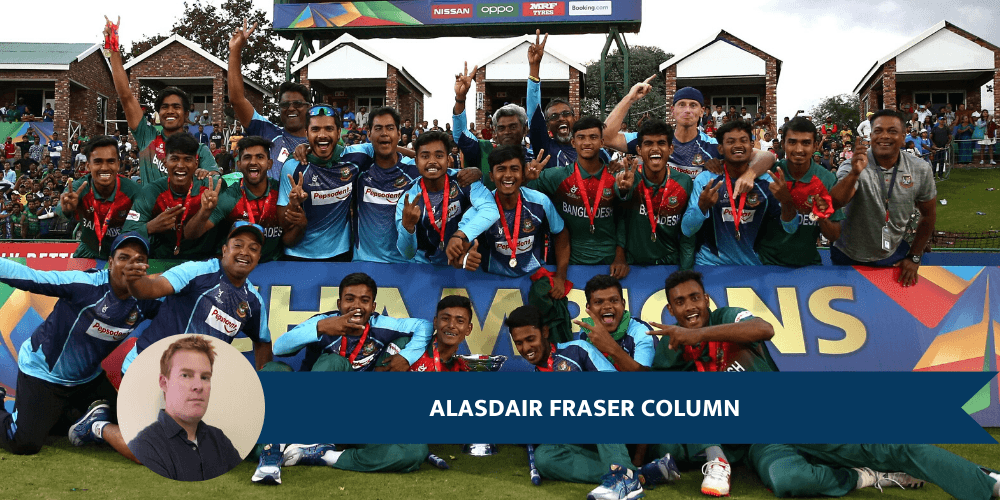
Given the recent boardroom woes in South African cricket and the Junior Proteas finishing a poor eighth at the U19 World Cup held here, it would be a step in the right direction to take a few positives from Bangladesh’s blueprint, writes Alasdair Fraser.
Apart from the ugly scenes that followed Bangladesh’s impressive three-wicket win, nothing can be taken away from their performance. Both teams had a part to play in the heated exchanges, though, but you could see the frustration and growing anger coming from India.
It’s amazing to see how such a cash-strapped nation, with limited playing resources and a relatively smaller player pool to choose from, can achieve a massive result by beating cricket’s ‘Big Brother’.
The India U19 side has an embarrassment of riches, with a coaching set-up the envy of most senior cricket teams, huge player depth and well-documented access to funds that most can only dream of.
The South African U19s have been dismal over the past few years. The fact that Lawrence Mahatlane was ‘happy’ with finishing eighth is akin to celebrating mediocrity at its finest. Sorry, but it’s unacceptable to be happy with losing to Afghanistan and beating Canada and UAE – both minnows of the game.
The Junior Proteas were always going to be thwarted in the playoffs by a Bangladesh outfit that gave India problems in the Asia Cup final five months ago. But given the excellent schools cricket we have in this country; it’s not acceptable to believe finishing eighth out of 13 teams is OK.
It would be interesting to see what debrief, or post-tournament report comes out from this. Since being crowned champions in 2014, the Junior Proteas have finished 11th (2016), fifth (2018), and eighth. Not very good, considering a good chunk of the players in our domestic scene featured in 2016 and 2018.
The microscopic lens into the current set-up is even more introspective when one of the glaring omissions from that SA U19 squad was Ruan Terblanche, who recently struck 323 not out in a recent friendly.
RUAN TERBLANCHE: I LEARNT MORE ABOUT STRUCTURING A LONG INNINGS
Or the lack of ability when our batsmen are faced with facing spin bowlers. The latter reminds me of when South Africa were readmitted to world cricket in 1991. Our senior batsmen were bamboozled by spin bowlers in the first couple of years. Three decades later and it’s worse!
But it would be unwise to dwell on the past. There is a new development in the background of our cricket – one that has the potential to change the path of a ship destined for a mighty iceberg.
We are seeing encouraging signs from the Proteas ODI squad. There is fresh blood in our team with a few old heads in the mix. Mark Boucher the coach must be afforded the same respect given to him during his days as Mark Boucher the player. It’s a tightrope he is currently walking on – one that was created long before he joined the coaching set-up.
Already we have seen performances from the new crop of players and the T20 series against England and Australia becomes even more important with a view to the World Cup in Australia later this year.
The Proteas have enough T20 game time against the Big Three in the coming months to warrant a decent enough introspection into the youthful state of our game to be able to make the right team selections for that World Cup. For now, that should be the only focus.
But it would be a massive step in the right direction if CSA are to make good on their commitment to Vision 2023 and unpack the merits of what Bangladesh’s youth cricket structure has been able to achieve with the limited resources they have.
South Africa has unbelievable sporting talent that hasn’t even been tapped into, while many players slip through the system through flawed selections, and it’s time for that to end.
Disclaimer: Cricket Fanatics Magazine encourages freedom of speech and the expression of diverse views from fans. The views of this article published on cricketfanaticsmag.com are therefore the writer’s own and do not necessarily represent the views of the Cricket Fanatics Magazine team.
Photo: ICC
FAF DU PLESSIS: KYLE VERREYNNE DOING "ALL THE RIGHT THINGS" TO GAIN PROTEAS RECOGNITION
by Daniel Orsmond

There’s a number of ways to improve cricket in South Africa, but I don’t think dropping the franchise system is one of them, writes Daniel Orsmond.
“To improve our Test cricket, we should drop the 6 team Franchise system for the 12-team provincial system to give more youngsters a chance to play longer format cricket at an earlier age and to expose them to the requirements of Test cricket”
I disagree, but let’s take a step back…
Cricket South Africa initially proposed a restructuring of our local cricket scene (which has been recently rescinded).
For those who are unaware, we currently have a two-tier system, franchise cricket, and semi-professional (provincial) cricket. There are 6 franchise teams in South Africa, the Titans, Lions, Cobras, Warriors, Knights and the Dolphins.
This is the highest tier of local cricket we have and acts as the ‘feeder’ into the national side.
Each side has 18 contracted players which equates to 108 contracted franchise players. Below these franchise sides, we have our 13 semi-professional sides which act as ‘feeders’ into our franchise teams.
Each semi-professional side has 13 contracted players which equates to 169 contracted semi-professional cricketers (a combined total of 277).
The semi-professional sides are:
1. Eastern Province
2. Gauteng
3. Free State
4. Easterns
5. Boland
6. Kwazulu Natal Inland
7. Northerns
8. Northern Cape
9. North West
10. Kwazulu Natal Coastal
11. Western Province
12. South Western Districts
13. Border
Getting back to the issue at hand, many would argue that we are losing too many youngsters too early in their careers due to their inability to be absorbed by the semi-professional or franchise system ultimately forcing them to either pursue a cricketing career abroad, or a career outside of cricket.
A further argument is that a semi-professional contract is in itself not enough to ‘convince’ or lure players into the system, given the modest nature of its terms and conditions.
What does scrapping the franchise system mean then?
Well, in my opinion, it means the following:
1. It doesn’t equate to more players in the system:
There will be fewer contracted players i.e. From 277 (currently) to 216 if each of the 12 provincial sides under the proposed system were able to offer 18 contracts.
This would imply that the same amount of money that is available for players’ salaries would be shared over fewer contracts which in turn results in the average salary per player increasing.
That does not necessarily mean that each players salary would increase, it means the mean salary will increase. Having said that, is there a financial benefit to CSA if the same amount of money is being spent on wages?
Well yes. Logistically speaking, there will be fewer games played with 12 provincial sides compared to the 6 franchise and 13 semi-professional sides.
This would involve a lot less travel, accommodation, umpiring fees, ground staff fees and administration as a whole and I would go as far as to say that the financial benefit was the main driver behind CSA’s initial decision to restructure the local system.
Even if it were to be at the expense of the quality of South African cricket. In the end, all I can say is that sanity seems to have prevailed….for now at least.
2. The standard of cricket will NOT improve:
Personally, I believe that the best of the franchise system that is competing for a place in the national side, are ill-prepared when they do finally get the Proteas call up.
This isn’t to say they are not quality cricketers, and it is in no way a knock on their individual work ethic, but rather a statement that speaks to the quality of cricket that they are exposed to at a franchise level relative to Test cricket. I believe that right now, the gap is just far too wide.
Before you bite my head off, of course, franchise cricket can’t be the same quality as Test cricket. I understand that, but I believe that not too long ago, each franchise side had at least a couple of Test calibre players who improved the quality of the system as a whole.
Why do I think that the quality seems to have decreased considerably? A couple of reasons really.
Firstly, Proteas players just don’t seem to play any local cricket anymore. Obviously, the fringe players will come out for their respective franchise sides, but the likes of Dale Steyn, Quinton de Kock, AB de Villiers, Faf du Plessis, Morne Morkel and so on, do not or did not play enough franchise cricket compared to the likes of Shaun Pollock, Mark Boucher, Graeme Smith, JP Duminy, Herschelle Gibbs and anyone else from that ‘era’. Simple as that.
Secondly, we have seen an increase in the number of players who have opted for Kolpak contracts who are generally your ’next in line’ type of players i.e. your Kyle Abbotts, Duane Oliviers, and Stiaan van Zyl’s who were top performers at a franchise level, but in and out of the national side during the ‘peak’ of their careers.
The combined loss of Proteas players not playing franchise cricket, former Proteas not staying in the system, and the rapid increase in Kolpak signings has resulted in a ‘softer’ looking franchise system.
We ask ourselves why top-quality batsmen who average in and around that 50 mark at a franchise or first-class level are unable to maintain that level of performance at Test level. We also wonder why they are not really able to convince selectors and fans that they even belong at that level at all.
Having said that, how would this all be affected if the franchise system were to come to an end at the expense of 12 provincial teams?
Because It makes matters worse. Using a practical example, I’d argue that between our 6 franchises, we have only a handful of players who really have the ability to come into the Test side right now and look like they ‘belong’ i.e. Dane Paterson, Beuran Hendricks and Lutho Sipamla.
Beyond those limited few, we have a decent number of franchise-quality bowlers who may or may not develop into bowlers who could start to push for that ‘back-up role’ should an injury arise or if they were selected for the shorter format.
At the same time, they are constantly putting in decent performances for their respective franchises.
The rest of the bowling attack consists of guys who have performed well at a semi-professional level but can often look out of depth when coming up against quality franchise batsmen.
If we were to now take these 24 bowlers (4 bowlers from each franchise) and spread them over 12 provincial teams, what happens to the average quality of each team’s bowling unit? It decreases substantially in my opinion. Do we have 48 quality bowlers in South Africa to fill those 12 teams?
No, I don’t believe so, and more importantly, it does not address my concern that our batsmen are coming into Test cricket ill-prepared to face Test level bowlers.
What is the solution then?
It’s quite easy for me to sit here in front of my screen and criticise each and every aspect of CSA and our local cricket system, but what practical solutions do I have to offer?
My first suggestion, as frustrating as it seems, is to sit tight and see how the Kolpak/Brexit situation unfolds. Best case scenario, we see an influx of some quality cricketers back into the franchise system which will make the world of difference.
I mentioned earlier that each franchise side seems to be sporting at least one or two players who perhaps struggle to cope at that level and it would be these players who would potentially be replaced by the returning Kolpak signings.
It’s not written in stone and their places are in no way guaranteed, but I believe that likes of Simon Harmer, Kyle Abbott, Rilee Rossouw, Hashim Amla, Morkel, Olivier, Leus du Plooy, Colin Ingram Dane Vilas, David Wiese, Wayne Parnell and Van Zyl wouldn’t have too much trouble convincing selectors of their quality.
Right off the cuff, our local batsmen would be exposed to the likes of Morkel, Abbott, Olivier, and Harmer who have all tasted success at Test level.
Would our batsmen score as many runs as they are now? Maybe, maybe not, but I feel fairly confident to say that they would be better prepared to walk into a boxing day Test to face James Anderson, Stuart Broad, and Jofra Archer.
Would our local bowlers benefit from bowling to the likes of Amla, Rossouw, Du Plooy, Ingram etc, yes I think they will.
The margin for error becomes smaller and smaller when you play against top opposition and a lack of discipline from our fringe bowlers at the moment is one of the most alarming issues in my opinion.
Having said that, are we likely to see a massive influx of these players back into the franchise system? I honestly don’t know. My guess is as good as yours.
The ECB will need to decide whether or not to increase the number of overseas professionals from one to two players per side. If that is the case, the Kolpak players might opt to play as overseas professional in county cricket but at the same time being available for selection for the Proteas.
That sounds great on paper, but if we actually stop and take a look at how many of those players would walk into the current national side, only Abbott and Olivier really get me thinking.
South African cricket would benefit far more from having these players playing franchise cricket than they would have them available for international selection.
Secondly, and more practically, I think that CSA is over-egging the pudding with 13 semi-professional sides.
I think that needs to be reduced dramatically to around 6-8 and should be effectively operating as a B team to the franchise sides.
For example, I don’t believe that it is completely necessary for the Western Cape to have 3 semi-professional sides (Boland, WP, SWD) ‘feeding’ the Cape Cobras, especially when their individual ‘contribution’ of players to the Cobras is heavily skewed.
Does Natal need an Inland and a coastal side? No, I don’t believe they do.
By cutting the number of semi-professional cricketers in half, you essentially increase the overall quality of that tier, and in turn, the quality of the players that eventually move up to the franchise or national level.
Some might argue that we lose a lot of potential cricketers in doing so but if we’re honest with ourselves and as controversial as it may sound, I believe that the financial gain from scrapping those sides far outweighs the potential loss of the ‘bottom half’ of the semi-professional circuit.
The financial gain could be used to retain top players who may be considering moving abroad, it could be used to bring in international coaches, or simply to improve infrastructure, but at the end of the day, there is a financial benefit that has NOT come at the expense of the quality of South African cricket!
Follow Dan on Twitter and Check out his Website
Disclaimer: Cricket Fanatics Magazine encourages freedom of speech and the expression of diverse views from fans. The views of this article published on cricketfanaticsmag.com are therefore the writer’s own and do not necessarily represent the views of the Cricket Fanatics Magazine team.
Photo: Deryck Foster/BackpagePix
“THE POT OF GOLD IS SOMETIMES WHERE YOU ARE” – GRANT THOMSON
Khalid Mohidin chatted to Grant Thomson about his journey, the standard of domestic cricket and weighing up the options of playing overseas or staying in South Africa.
“The pot of gold is sometimes where you are.”
Those are the words that stuck with me during my interview with Titans 4-day captain Grant Thomson. This was his message to young cricketers.
We often see how young cricketers up and leave when things don’t go the way they planned. They’ve put in hard work, and like Thompson explained “when they hit 23/24 years old, look for greener pastures.”
There are cases in recent times that raise eyebrows, where players have left at a young age, without really trying to push for higher honours, playing only one season of domestic cricket, or who haven’t even broke into the franchise circuit yet.
Then there are others, like the likes of Rassie van der Dussen, Jon-Jon Smuts, Beuran Hendricks and even Thomson who have stuck it out and reaped the rewards.
In this interview, Grant Thomas chats about a number of issues in South African cricket, but instead of focusing on the negatives, he gave a positive message and outlook.
